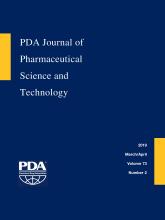Abstract
Vial capping plays a critical role in the drug product manufacturing process owing to the complex interplay of several adjustable process steps. Seal quality and integrity and containment assurance are essential for parenteral pharmaceuticals, as the vial's content may be contaminated or, in the case of highly potent drugs (e.g., antibody drug conjugates), may bear a risk of contamination. The residual seal force (RSF) method can enable further insight in capping equipment settings independently of the container closure system (CCS) and their resulting seal quality.
The present study investigates the accuracy of the RSF method focusing on different force settings, RSF development over time, distance between capping plates and vial neck (roller-axis), time point of flip-off button removal, and internal and external vial pressure differences (flight simulation and vials closed under vacuum).
Results show that the forces used on an RSF tester should be kept low to minimize CCS deformation, and a period of stable RSF values after the initial decrease should be implemented between capping and RSF measurement to increase accuracy. Variations in the distance between the capping plates and vial neck (roller-axis) can result in incomplete crimps or visual defects of the seals. In addition, the time point of flip-off button removal as part of the sample preparation had no significant impact on RSF measurements. Finally, pressure differences between the vial interior and exterior had no significant impact on the RSF data.
LAY ABSTRACT: Vial capping plays a critical role in the drug product manufacturing process due to the complex interplay of several adjustable process steps. Seal quality, integrity, and containment are essential for parenteral pharmaceuticals, as the vial's content varies and may be contaminated, sensitive to stress, and/or highly potent (eg, antibody drug conjugates). The residual seal force (RSF) method can enable further insight in capping equipment settings independently of the container closure system and their resulting seal quality.
In this study, we determined RSF values by applying different force settings of the RSF tester and investigated the influence of sample preparation on the determination of RSF. Furthermore, the capping process parameter roller-axis was evaluated by RSF and visual inspection. In addition, we investigated the influence of pressure differences of vials on the RSF as they occurred during air transport and products closed under vacuum.
- © PDA, Inc. 2019
PDA members receive access to all articles published in the current year and previous volume year. Institutional subscribers received access to all content. Log in below to receive access to this article if you are either of these.
If you are neither or you are a PDA member trying to access an article outside of your membership license, then you must purchase access to this article (below). If you do not have a username or password for JPST, you will be required to create an account prior to purchasing.
Full issue PDFs are for PDA members only.
Note to pda.org users
The PDA and PDA bookstore websites (www.pda.org and www.pda.org/bookstore) are separate websites from the PDA JPST website. When you first join PDA, your initial UserID and Password are sent to HighWirePress to create your PDA JPST account. Subsequent UserrID and Password changes required at the PDA websites will not pass on to PDA JPST and vice versa. If you forget your PDA JPST UserID and/or Password, you can request help to retrieve UserID and reset Password below.






